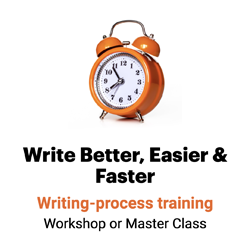Get words on paper faster
There comes a point in any writing project when you need to follow Ernest Hemingway’s rule for writers: Apply the seat of your pants to the seat of a chair.

That is, you have to write. That’s the second step of the writing process: freewriting.
Only forget that kind of writing where you:
- Hunt for the right word.
- Peck it out.
- Shuffle through notes looking for a quote.
- Head to the vending machines for the third time in 15 minutes, hoping that when you come back you might — just might — think of something to say.
Nothing gets words on paper faster or gives your writing more personality than freewriting.
Freewriting is based on the idea that our brains are divided into two parts:
- The logical left side. It thinks analytically, making sure you don’t end your sentences in prepositions or use a colon when only a semicolon will do.
- The creative right side. It’s impulsive and unconventional and gives your copy interest and energy.
Problem is, we weren’t taught how to use the right side of our brains to write. Instead, we focus on AP style, punctuation and spelling — editing.
Freewriting momentarily gets rid of the brain’s logical left side so you can tap its creative right side.
How a writer writes
So after you prewrite and take a break:
1. Divide and conquer.
Freewriting is intense, high-energy work. You’ll only be able to tackle a small portion at a time.
So break your project up. Instead of challenging yourself to write a whole piece, think sections, paragraphs or sentences:
- Don’t write a press release; write the headline, deck and lead.
- Don’t write a speech; write the introduction.
- Don’t write a blog post; write the first three tips.
For this article, for instance, I divided the project into five sections:
- Freewrite your copy.
- Divide and conquer (this section).
- Write quickly, without stopping.
- Banish the grammar police.
- Take a break.
Once I finish each section, I get to take a break.
Which is … now. Please excuse me while I go check my email.
2. Write quickly, without stopping.
When you’re writing, write. Don’t edit.
That’s the purpose of freewriting: to get words on paper (or pixels).
The problem is, if you write down a few words and then stare at them, you’ll edit. You won’t be able to help it. But if you force yourself to write continuously and quickly, you’ll push through that conditioned impulse to fix your copy and actually get some writing done.
When you freewrite, you want to achieve what the folks who study creativity call “flow.” In flow, you feel as if the words are flowing from your fingers — as if you can hardly keep your hands moving fast enough to keep up with your ideas.
Because of all the work you did in the prewriting step of the process — and because you’ve selected a discrete section of your piece to write — you should never have to stop to ponder where your piece is going next or how you’re going to get there.
You want to think through writing rather than thinking before you write. It’s stream of consciousness.
So get your nose out of your notebook. The story isn’t there; it’s in your head. (You’re not writing a research paper, after all. You’re not writing a report.)
Let the momentum of writing carry you along.
That’s flow.
3. Banish the grammar police.
“The beautiful part of writing is that you don’t have to get it right the first time,” said American author Robert Cormier, “unlike, say, a brain surgeon.”
Agreed.
When I started writing this piece, I wasn’t sure how to spell Cormier’s name. But if I’d stopped writing long enough to confirm that Cormier isn’t spelled with a “U,” I would have made the transition from writer to editor.
When you’re freewriting, the minute you stop to correct something, the left side of the brain wins out, and you have to start all over again the process of getting into writing mode.
Instead, lock the editor out and let the writer create. Keep the good ideas and fresh prose flowing.
It’s the writing strategy of experienced writers: Don’t worry about mistakes when you’re writing. Use a dash instead of a semicolon, write “you’re” when you mean “your” — even misspell the CEO’s name. You can always go back and fix your mistakes later, during rewriting.
What you can’t do is go back and breathe life into a stillborn draft — a draft that never really got written in the first place
4. Take breaks.
Freewriting is intense. Your creativity and energy will flag if you stay at it for too long.
So give yourself a time limit. So set your timer or internal clock for no less than five minutes, no more than 15.
When your time’s up, take a break. Make a Diet Coke run. Check your email. File your notes.
Then get back to the job. That minute or two away from the page will leave you refreshed, refueled — and ready to go again.
You might try taking your break in the middle of a thought — even the middle of a sentence. You’ll eliminate re-entry problems and be itching to start again.
“I always stopped when I knew what was going to happen next,” Hemingway wrote. “That way I could be sure of going on the next day.”
Don’t let your Red Bull run turn into a couple of hours on Google, a Facebook binge or a major filing system reconstruction. At some point, you need to get back to the keyboard and write.
___
Source: Peter Elbow, “Freewriting,” excerpted from Writing Without Teachers, Oxford University Press, 1973

Leave a Reply